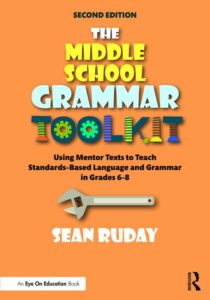A Craft Tool Approach to Grammar Instruction

Whenever I speak with students or fellow teachers about effective grammar instruction, I emphasize the relationship between grammatical concepts and a creator’s tools. An effective writer uses each grammatical concept purposefully, just as a skilled craftsperson uses a tool with a clear understanding of the reasons for using it.
Whether an author is using intensive pronouns to emphasize a key detail, complex sentences to provide additional context and explanation, strong verbs to maximize clarity, relative clauses to provide identifying information, or any other grammatical concept, it’s important that they understand the usefulness of that concept and its impact on their writing.

I’ve found that when students understand that writers use specific grammatical concepts in intentional and strategic ways, they can begin to look at grammar differently, seeing it as a series of tools and skills they can apply to their writing rather than the content of workbook exercises with little connection to other aspects of literacy.
A seventh grader with whom I recently worked explained meaningful grammar instruction like this: “I always thought grammar workbooks were annoying and a waste of time. I didn’t learn anything (from them). Talking about grammar as the tools of good writing makes grammar more useful, and I like that much better.”
My Six-Step Process
To help students approach grammatical concepts as tools that authors use purposefully to maximize the effectiveness of their works, I use an instructional process designed to help students think carefully about and reflect on the importance of grammatical concepts to effective writing. When I put this process into action, I follow six steps:
► Discuss the fundamental components of a grammatical concept.
► Show students published examples of this concept.
► Discuss with students why the grammatical concept is important to the published examples.
► Have students work in small groups to analyze the importance of a grammatical concept.
► Have students apply a specific grammatical concept to their own writing.
► Ask students to reflect on the importance of a grammatical concept to effective writing.
Now, let’s take a look at each of these ideas in more detail.
Step One: Discuss the Fundamental Components of a Grammatical Concept
Before students begin thinking about how published authors use a specific grammatical concept/tool and why it is important to effective writing, they must understand the fundamentals of that concept. I teach this information through brief, focused mini-lessons that introduce students to the key components and features of that concept.
Once I feel that students are comfortable with this information, I move forward in the process and begin to challenge them to think in more depth about the concept and how it is an important aspect of effective writing.
Step Two: Show Students Published Examples of this Concept
After the students have developed an understanding of the fundamentals of a particular grammatical concept, we teachers can deepen their awareness of that tool by showing them published examples of its use. When students see published examples of a grammatical concept, they can begin to understand that elements of grammar are not simply things to be learned in isolation and used on worksheets; they are integral aspects of quality writing.
I ask myself three questions when selecting a published example of a particular grammatical concept to show my students: (1) Does this example clearly illustrate the grammatical concept I want my students to learn? (2) Is this example from a text that is age and reading level appropriate for my students? (3) Do I believe my students will be interested in this example?
If I answer “yes” to all three of these questions, then I know the mentor text is one I will use.
Step Three: Discuss with Students Why the Grammatical Concept Is Important to the Published Examples You Have Shown Them
Once you have shown students examples of published texts that contain a particular grammatical concept, the next step is to talk with them about why that grammatical concept is important to those particular texts. While the specific nature of these conversations will vary based on the tool you are describing, the main focus will remain the same: why the grammatical concept being discussed is important to the piece of writing.
For example, a conversation about the active voice will differ from a discussion about relative clauses, but each conversation should address the importance of the concept being described and help students reflect on its importance.
When having these discussions with students, I recommend focusing on two key questions: (1) Why did the author use this particular tool – this grammatical concept? (2) What would this piece of writing be like if this concept was not used? These questions help students consider how grammatical concepts are tools that writers use purposefully to improve their works.
Step Four: Have Students Work in Small Groups to Analyze the Importance of a Grammatical Concept
At this point in the instructional process, you have taught students the fundamental components of a grammatical concept, have shown them examples from published texts of that concept, and have talked with them about why that concept is important to those published works. Now, the students are ready to take more of an active role in their learning by working in small groups to think further about the importance of this particular grammatical tool.
The specific ways students will engage in these analyses will vary based on the concept they’re studying. For example, when working on prepositional phrases, I will ask students to find examples of prepositional phrases in literature and explain why the author of that piece used that concept.
Regardless of concept-specific variations, the most important elements of this activity are that students are taking increased ownership for their learning and are working together to analyze the importance of the grammatical tool they are studying. After students complete their small group analysis, I recommend having them share their ideas with the whole class so that all can benefit from each group’s work on the concept.
Step Five: Have Students Apply a Specific Grammatical Concept to Their Own Writing
This step of the instructional process places even more responsibility on the students, as it requires that they work independently to use the focal grammatical tool in their writings. If students are already working on a particular piece of writing, you can ask them to apply the grammatical concept you are focusing on to that piece. For example, if the class is studying specific nouns and strong verbs, you can ask the students to focus on applying these concepts as they continue to work on their pieces.
While your students work on using a specific grammatical concept, I recommend holding individual writing conferences with them in which you talk with them about the ways they are using the concept. These conferences are great opportunities to ask students to show you examples of this concept in their work, talk with students about its importance, and clarify any confusion students have.
Step Six: Ask Students to Reflect on the Importance of a Grammatical Concept to Effective Writing
The final step of this process, in which students reflect on the importance of a particular grammatical concept to effective writing, further encourages them to think about the significance and relevance of grammar. I recommend engaging students in this kind of reflection by asking them why a grammatical concept is important to good writing and having the students first discuss this question in small groups and then with the whole class.
For example, when working with seventh graders on connotation, I posed the question: “Why is it important that writers understand the connotations of their words?” The students reflected on this concept, with one pointing out that accidentally using a word with a negative connotation could upset a reader.
When asking students to reflect on the importance of a grammatical tool, I encourage you to help students make connections to the writing they do outside of school; these kinds of connections can make a particular concept even more relevant.
For example, one student, when describing the importance of connotation, pointed out that it is important to understand the connotations of particular words when using them in text messages. This student’s comment shows an understanding of this grammatical concept and an awareness of how it relates to middle school students’ everyday lives.
Closing Points
As you work with your students on grammar instruction, I recommend emphasizing that grammatical concepts are key parts of a writer’s toolkit. An understanding of each of these tools will help today’s students develop into thoughtful readers and writers who understand that grammar is more than a series of workbook exercises: it is a key element of how writers communicate effectively.
Students who understand this can read and write with an awareness of why writers do what they do and contribute to the world with their strong communication skills and artful use of grammar’s tools.

Sean has written 12 books with Routledge/Eye On Education, including The Middle School Grammar Toolkit: Using Mentor Texts to Teach Standards-Based Language and Grammar in Grades 6–8, 2nd Edition. Read Sean’s take on the book here. You can follow Sean on Twitter at @SeanRuday and visit his website at www.seanruday.weebly.com.

































